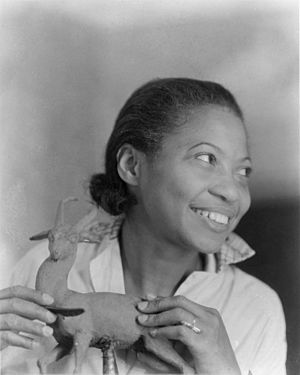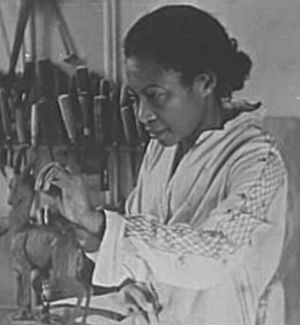Augusta Savage facts for kids
Quick facts for kids
Augusta Savage
|
|
|---|---|

Augusta Savage
|
|
| Born |
Augusta Christine Fells
February 29, 1892 Green Cove Springs, Florida
|
| Died | March 27, 1962 (aged 70) New York
|
| Nationality | American |
| Education | Cooper Union, Académie de la Grande Chaumière |
| Known for | Sculpture |
|
Notable work
|
Gamin W.E.B Dubois Lift Every Voice and Sing |
| Movement | Harlem Renaissance |
| Spouse(s) | John T. Moore James Savage Robert L. Poston |
| Patron(s) | Teachers from Florida A&M, Julius Rosenwald Fund |
Augusta Savage (born Augusta Christine Fells; February 29, 1892 – March 27, 1962) was an important American sculptor. She was a key figure in the Harlem Renaissance, a time when Black artists, writers, and musicians created amazing works. Augusta Savage was also a dedicated teacher. Her art studio helped many young artists become famous. She worked hard to gain equal rights for African Americans in the art world.
Contents
Early Life and Artistic Beginnings
Augusta Christine Fells was born in Florida on February 29, 1892. Her father, Edward Fells, was a Methodist minister. As a child, Augusta loved making small animal figures from the red clay in her hometown.
When her family moved to West Palm Beach in 1915, her new high school principal encouraged her talent. He even let her teach a clay modeling class. This experience started her lifelong passion for teaching art.
In 1907, at age 15, Augusta married John T. Moore. They had a daughter named Irene Connie Moore. John passed away shortly after Irene was born. In 1915, she married James Savage and kept his last name even after they divorced. Later, in 1923, she married Robert Lincoln Poston. He sadly died in 1924 while traveling.
Education and Early Career in Art
Augusta continued to create clay models. In 1919, she won a $25 prize at the Palm Beach County Fair for her unique artwork. After this success, she moved to New York City in 1921. S
She applied to Cooper Union, a special school that offered scholarships. She was accepted in October 1921, chosen over many other students. Her talent impressed the school, and she received extra money for living expenses.
After graduating, Savage worked in laundries to support herself and her family. Her family from Florida moved in with her after a hurricane destroyed their home. During this time, she received her first important art job. She was asked to create a bust (a sculpture of someone's head and shoulders) of W. E. B. Du Bois. He was a very important civil rights leader. Her amazing sculpture led to more commissions, including one of Marcus Garvey.
In 1923, Savage was accepted into a summer art program in France. However, the American committee took back her acceptance when they learned she was Black. They worried that white students would not be comfortable. Savage was very upset and fought against this unfair decision. She wrote a letter to the New York World newspaper. This was one of her first public fights for equal rights. Even though she could not attend that school, the incident brought attention to her talent. Another sculptor, Hermon Atkins MacNeil, invited her to study with him.
In 1929, with help from various groups and friends, Savage finally traveled to France. She was 37 years old. She studied at the Académie de la Grande Chaumière, a famous art school in Paris. She also studied with sculptor Charles Despiau. She showed her art and won awards at the Paris Salon. She also traveled through France, Belgium, and Germany to study sculptures in museums and cathedrals.
Later Career and Teaching Impact
Savage returned to the United States in 1931, full of energy and new ideas. However, the Great Depression made it very hard to sell art. Despite this, she continued her work.
She opened the Savage Studio of Arts and Crafts in Harlem. She welcomed anyone who wanted to learn to paint, draw, or sculpt. Many of her young students became famous artists, including Jacob Lawrence and Norman Lewis.
In 1937, Savage became the director of the Harlem Community Art Center. About 1,500 people of all ages took part in her workshops. Her diverse staff taught art, and students showed their work around New York City. Funds from the Works Progress Administration helped. But Savage still faced discrimination from officials who did not want a Black woman in a leadership role.
Augusta Savage was one of only two African Americans and four women chosen to create a sculpture for the 1939 New York World's Fair. She was asked to create a sculpture showing the impact of Black people on music. She created Lift Every Voice and Sing, also known as "The Harp." It was inspired by the famous song.
The sculpture was 16 feet tall and made of plaster. It stood in front of the Contemporary Arts Building. It was one of the most popular and photographed artworks at the fair. Small souvenir copies were sold. The sculpture looked like a harp with 12 singing African-American youth as its strings. A young man knelt in front, offering music. Savage could not afford to have the sculpture made into bronze or stored. So, like other temporary art at the fair, it was destroyed when the fair ended.
Savage opened two art galleries. Her shows were well-attended and received good reviews. However, few artworks were sold, and the galleries closed. Her last major art show was in 1939. Feeling sad about her money problems, Savage moved to a farmhouse in Saugerties, New York, in 1945.
In Saugerties, she became close with her neighbors. She welcomed family and friends from New York City. She grew a garden and sold chickens and eggs. She also worked as a laboratory assistant at a company that grew mushrooms for cancer research. Her boss encouraged her art and gave her supplies. While she made less art, she taught children in summer camps. She also sculpted friends and explored writing children's stories.
One of her most famous busts is called Gamin. It is on display at the Smithsonian American Art Museum in Washington, D.C. A life-sized version is at the Cleveland Museum of Art. Gamin was modeled after a young person from Harlem. It was voted the most popular work in an exhibition of over 200 artworks by Black artists. Her art style was realistic, expressive, and full of feeling. While her art and influence are well known, the location of many of her works is a mystery.
Augusta Savage moved in with her daughter, Irene, in New York City as her health declined. She passed away from cancer on March 26, 1962. Even though she died quietly, Augusta Savage is remembered today as a great artist, activist, and art teacher. She inspired many people she taught, helped, and encouraged.
Legacy and Recognition
The Augusta Fells Savage Institute of Visual Arts, a public high school in Baltimore, Maryland, is named in her honor.
In 2001, her home and studio in Saugerties, New York, were added to the New York State and National Register of Historic Places. This site is important because it shows where this famous artist, teacher, and activist lived and worked. Her home has been restored to look like it did when she lived there. It helps tell the story of her life and artistic vision.
In 2007, her hometown of Green Cove Springs, Florida, nominated her for the Florida Artists Hall of Fame. She was inducted in the spring of 2008. Today, a Community Center at her birthplace is named after her.
A book for younger readers about Augusta Savage, called In Her Hands: The Story of Sculptor Augusta Savage, was written by Alan Schroeder. It was released in 2009.
Interesting facts about Augusta Savage
- When Augusta was a child, her father did not approve of her art. He believed it was wrong because of his religious beliefs.
- Savage moved to New York City with only $4.60 to pursue her art dreams.
- She finished her four-year degree in just three years.
- Much of her art was made from clay or plaster. She often could not afford to use bronze.
- In 1934, she became the first African-American artist elected to the National Association of Women Painters and Sculptors.
- Her papers and documents are kept at the Schomburg Center for Research in Black Culture at the New York Public Library.
- She taught and mentored many young artists who later became nationally famous, like Jacob Lawrence and Norman Lewis.
Works
- Portrait busts of W.E.B. DuBois and Marcus Garvey
- Gamin
- The Tom Tom
- The Abstract Madonna
- Envy
- A Woman of Martinique
- Lift Every Voice and Sing (also known as The Harp)
- Sculptural interpretation of Negro Music
- Gwendolyn Knight, 1934–35
Individual Exhibitions
- Grande Chaumière, Paris, 1929
- Salon d'Automne, Paris, 1930
- Argent Galleries, New York and Art Anderson Gallery, New York, 1932
- Argent Galleries, New York and New York World's Fair, 1939
- New York Public Library, 1988
Selected Group Exhibitions
- Argent Galleries, New York, 1934
- Argent Galleries, New York, 1938
- American Negro Exposition, Tanner Art Galleries, Chicago, 1940
- Newark Museum, New Jersey, 1990
- Three Generations of African-American Women Sculptors, Afro-American Historical and Cultural Museum, Philadelphia, 1996
See also
 In Spanish: Augusta Savage para niños
In Spanish: Augusta Savage para niños


